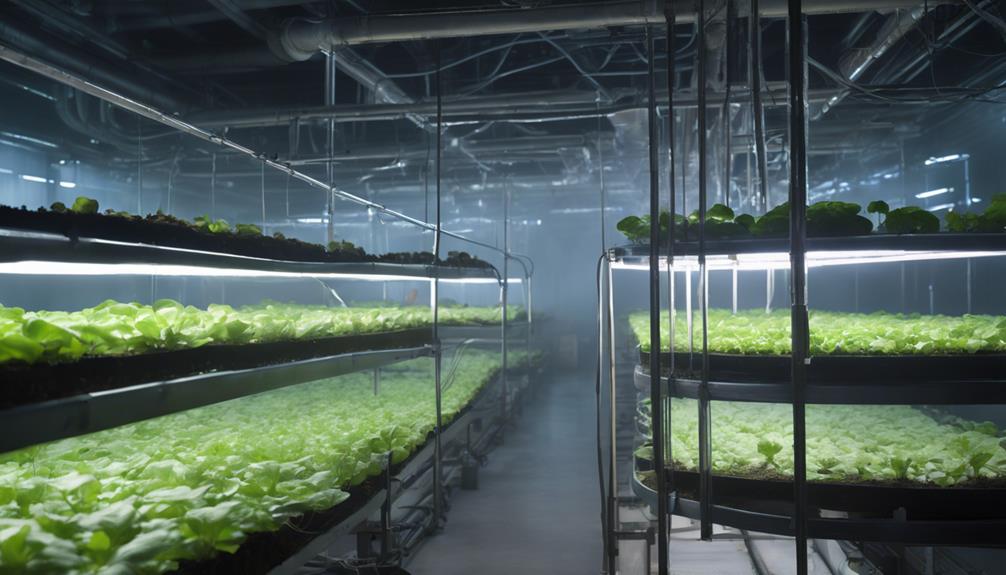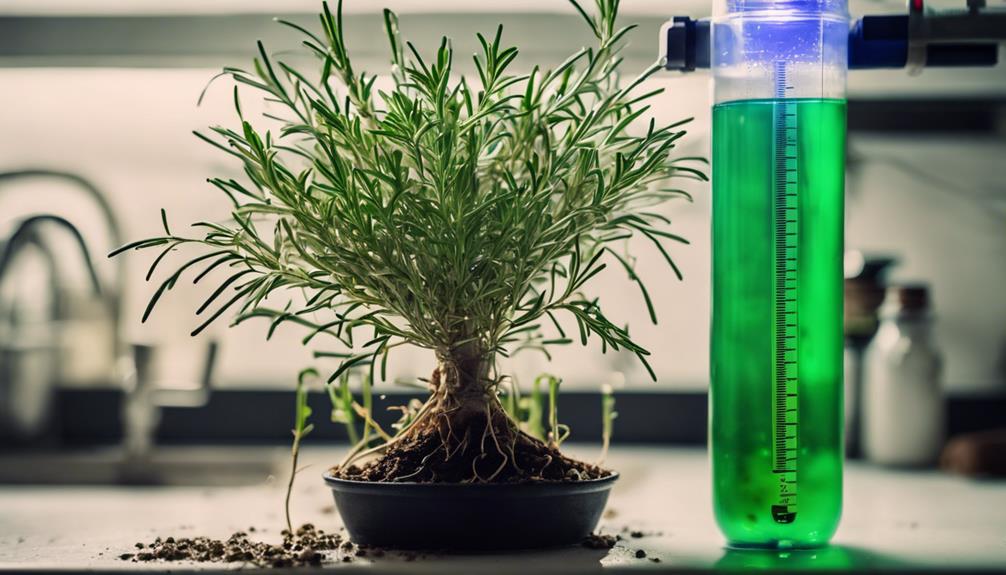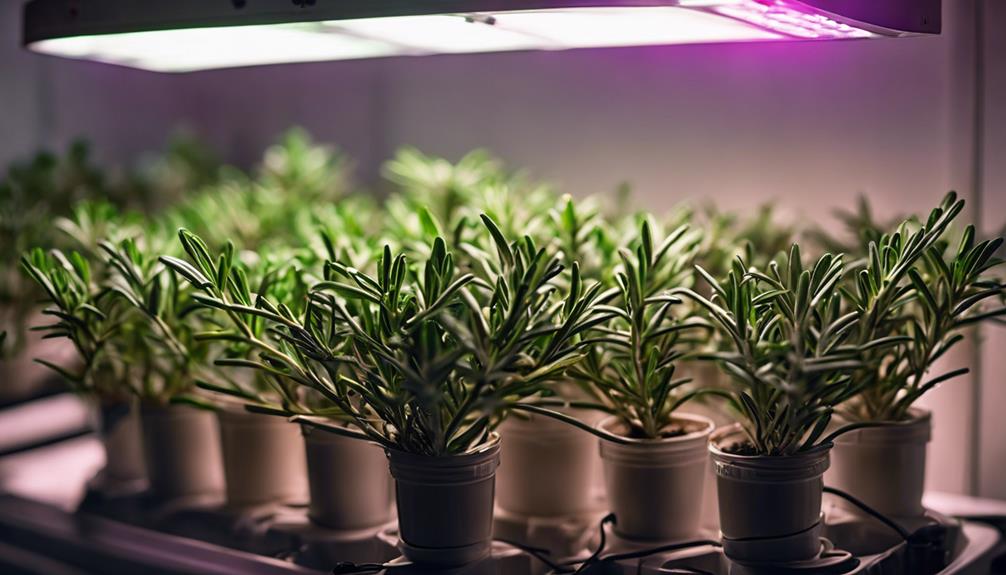An Introduction to Growing Rosemary Hydroponically Indoors
Growing rosemary hydroponically indoors can be a fun and rewarding experience. To get started, you’ll want to choose a variety of rosemary that does well indoors, such as ‘Arp’ or ‘Hill Hardy’. These types of rosemary are perfect for growing inside because they are more tolerant of indoor conditions.
Next, you’ll need to set up a hydroponic system that meets the needs of your rosemary plants. Two popular options for hydroponic systems are NFT (Nutrient Film Technique) and DWC (Deep Water Culture). Both of these systems work well for growing rosemary indoors.
Lighting and air circulation are also important for healthy rosemary growth. Make sure your plants are getting enough light, and that the air around them is circulating properly.
To keep your rosemary plants happy and healthy, you’ll want to maintain a consistent temperature between 65-75°F. You’ll also want to keep an eye on the pH levels of your nutrient solution, making sure they stay between 5.5-6.0.
Regularly checking and adjusting the nutrient solution is crucial for healthy plant growth. Aim for a balanced mix of nitrogen, phosphorus, and potassium. By monitoring and adjusting these levels, you’ll be on your way to growing delicious and fragrant rosemary indoors.
With a little practice and patience, you’ll be enjoying fresh, homegrown rosemary in no time. Remember to keep an eye on your plants and make adjustments as needed to ensure they’re getting everything they need to thrive.
GrowHydroHerbs TLDR
- Step 1: Choose the Right Variety: Select a rosemary variety that grows well indoors, such as ‘Arp’ or ‘Hill Hardy’. This will help your plant thrive in indoor conditions.
- Step 2: Set Up Your Hydroponic System: Create a hydroponic system that provides a balanced mix of nutrients (NPK) and controls the pH level. This ensures your rosemary plant gets the essential nutrients it needs.
- Step 3: Control Temperature and Humidity: Keep the temperature between 65-75°F and the humidity level between 40-60%. This will promote healthy growth and prevent problems.
- Step 4: Prune and Harvest Regularly: Prune your rosemary plant regularly to encourage bushy growth and prevent powdery mildew. Harvesting regularly will also help keep your plant healthy.
- Step 5: Monitor Water and Nutrients: Check the water level and nutrient solution daily to prevent overwatering. Make sure your plant gets fresh nutrients to stay healthy.
What is Rosemary and Why Would You Want to Grow it?
Rosemary is a perennial plant native to the Mediterranean. It has long been valued for its culinary and medicinal properties. With its strong, woody aroma and slightly bitter taste, rosemary is a popular herb in Mediterranean cuisine, enhancing the flavor of meats, soups, and stews.
Beyond the kitchen, rosemary has been used in traditional medicine to boost memory and concentration. Its’ essential oils are known for their antimicrobial and anti-inflammatory properties, making it useful in treating minor infections and skin irritations. Additionally, rosemary is believed to improve digestion, reduce stress, and even enhance hair health when used in various remedies.
Growing Rosemary Hydroponically Indoors? Choose the Right Variety
When growing rosemary indoors using a hydroponic system, it’s essential to pick a variety that thrives in indoor conditions. There are two main things to consider.
Selecting the Right Rosemary Type
You want to choose a rosemary type that does well indoors. This might seem obvious, but different rosemary varieties are better suited for different growing conditions.
Climate Tolerance is Key
You also need to think about the climate tolerance of the rosemary variety you choose. This means considering the temperature, humidity, and light levels in your indoor space. By thinking about these factors, you can pick a rosemary variety that will do well in your hydroponic setup.
Choosing the Right Rosemary Type for Hydroponic Growing
When growing rosemary indoors using hydroponics, selecting the right variety is crucial for success. One popular option is the original Rosmarinus officinalis. This type is widely used and can thrive in indoor conditions.
If you want a rosemary plant that can survive the winter months indoors, consider ‘Arp’ or ‘Hill Hardy’. These varieties are bred to be cold-hardy and can tolerate indoor conditions during the winter.
Other popular rosemary varieties for hydroponic growing include ‘Tuscan Blue’ and ‘Miss Jessop’s Upright’. These plants are known for their great flavor and aroma, making them perfect for cooking.
What to Consider When Choosing a Rosemary Type
When selecting a rosemary variety, think about the specific growing conditions and how you plan to use the plant. Hydroponics allows you to control the nutrient solution, so you can tailor it to your plant’s needs.
You can also use a greenhouse growing system to replicate ideal conditions. By choosing the right rosemary variety, you’ll give your plant the best possible start. This will help ensure a healthy and thriving rosemary plant indoors.
Climate Tolerance Factors
Growing rosemary indoors using a hydroponic system can be a challenge. But with the right variety and controlled environment, you can succeed. One crucial factor to consider is the climate tolerance of your rosemary variety. This means thinking about the temperature and humidity levels in your grow space.
Some rosemary varieties are more cold-tolerant than others. Some need warmer temperatures to stay healthy. When choosing a rosemary variety, you should consider these factors to ensure your plant thrives.
Here’s a list of popular rosemary varieties and their temperature and humidity tolerance:
| Variety | Temperature Tolerance | Humidity Tolerance |
|---|---|---|
| Arp | 40-75°F (4-24°C) | 40-60% RH |
| Hill Hardy | 40-75°F (4-24°C) | 40-60% RH |
| Tuscan Blue | 55-75°F (13-24°C) | 40-60% RH |
| Miss Jessop’s Upright | 55-75°F (13-24°C) | 40-60% RH |
| Upright Rosemary | 50-70°F (10-21°C) | 40-60% RH |
In a hydroponic system, you can control the temperature and humidity levels to optimize growth. Most rosemary varieties need at least 12 hours of light per day to grow well. You can use LED grow lights to provide the necessary light spectrum and hours.
Setting Up Your Hydroponic System

You’ve chosen the perfect rosemary variety. Now, it’s time to set up your hydroponic system. First, decide on the type of system that works best for your space and rosemary plant needs. Two popular options are NFT (Nutrient Film Technique) and DWC (Deep Water Culture).
Think carefully about your options and set up your tank correctly. This will help you keep an eye on the water quality and create an ideal environment for your rosemary plants to grow.
Choosing the Right System for Your Indoor Rosemary
When setting up a hydroponic system for growing rosemary indoors, it’s essential to choose a system that meets the plant’s specific needs. This includes a suitable growing medium, a balanced nutrient blend, and precise temperature and pH control.
A well-designed system will provide your rosemary plants with the ideal conditions for growth and health.
Key Factors to Consider
To ensure you choose the right system, consider the following factors:
- Growing Medium and Nutrient Solution: Look for a system that uses a suitable growing medium, such as rockwool. The system should also have a balanced nutrient blend specifically formulated for herbs.This will provide your rosemary plants with the necessary nutrients for healthy growth.
- Lighting and Temperature Control: Make sure the system provides adequate lighting. Your rosemary plants need at least 12-16 hours of light per day. The system should also maintain a consistent temperature between 65-75 degrees Fahrenheit. This temperature range is ideal for rosemary growth.
- pH Range and Air Circulation: Choose a system that can maintain a pH range of 5.5-6.0. This range is suitable for rosemary plants. The system should also provide good air circulation. Full spectrum grow lights with built-in fans can help with this.
By considering these factors, you can choose a hydroponic system that meets the unique needs of your rosemary plants.
This will help you grow healthy and thriving rosemary indoors.
Setting Up the Tank
Now that you’ve chosen the right hydroponic system for your indoor rosemary, it’s time to set up the tank. This tank will provide a stable nutrient solution for your plants to grow.
Choose the Right Tank
You’ll need a tank that can hold at least 10-20 gallons of water. Make sure it’s made of a safe material, like polypropylene or polyethylene. This will keep your plants healthy and prevent contamination.
Add a Water Pump
Next, install a submersible water pump. This pump should be able to move at least 100-200 gallons of water per hour. This will help circulate the nutrient solution and give oxygen to your rosemary plants’ roots.
Add Oxygen to the Water
To help your plants grow, you’ll also need to add an aeration system. This can be an air stone or a venturi aerator. These tools will increase the oxygen levels in the water, which will help your rosemary plants’ roots grow strong.
Control the pH and Temperature
To keep your plants happy, you’ll need to control the pH and temperature of the water. Install a pH controller and a temperature controller in the tank. These tools will help you keep the pH levels between 5.5-6.0 and the temperature between 65-75°F. This is the perfect range for rosemary plants to grow indoors.
Monitoring Water Quality for Healthy Rosemary Plants
When growing rosemary in a hydroponic system, it’s crucial to monitor the water quality regularly. This ensures your plants receive the best conditions to thrive. Let’s break down the key factors to check.
pH Levels: The Sweet Spot
The ideal pH range for hydroponic rosemary is between 5.5 and 6.0. If the pH levels are too high or too low, it can lead to nutrient deficiencies or even toxicity.
Nutrient Concentration: Getting it Just Right
Use an EC meter to measure the nutrient concentration in the hydroponic solution. Aim for a reading between 1.0 and 1.6 for rosemary. This will ensure your plants receive the necessary nutrients for healthy growth.
Temperature Control: Finding the Perfect Balance
Rosemary prefers temperatures between 65-75°F (18-24°C). Avoid sudden fluctuations, as they can impact growth and nutrient uptake.
Regular Maintenance: The Key to Success
Regular water changes (every 1-2 weeks) and cleaning of the hydroponic system are vital to prevent the buildup of toxins. This maintains the best water quality for your rosemary plants.
Nutrient Solution and Ph Levels

To help your rosemary plants grow strong and healthy using hydroponics, you need to get two things just right: the nutrient solution and the pH levels.
Let’s start with the pH levels. This measures how acidic or alkaline the solution is. For rosemary, you want the pH level to be between 5.5 and 6.0. If it’s outside of this range, it can hurt the plant.
Once you have the pH level where it needs to be, it’s time to focus on the nutrient solution. This is what feeds your plants and gives them what they need to grow. When you get this part right, your rosemary will get the best start in life.
To do this, you’ll need to learn what goes into making the perfect nutrient solution and how to maintain it.
Controlling pH Levels for Healthy Rosemary Growth
When growing rosemary indoors using hydroponics, it’s essential to keep an eye on the pH level of the nutrient solution. This is because the pH level directly affects how well your rosemary plant can absorb the nutrients it needs to thrive.
Why pH Levels Matter
The ideal pH range for rosemary growth is between 5.5 and 6.0. If the pH level is too high or too low, it can cause problems for your plant. For example, if the pH level is too low, your rosemary might get too much manganese, which can be toxic.
On the other hand, if the pH level is too high, your plant mightn’t get enough iron and other essential nutrients.
How to Control pH Levels
- 1. Check the pH level regularly: The pH level can change over time due to things like plant growth and nutrient uptake. So, it’s essential to check the pH level regularly to make sure it’s within the ideal range.
- 2. Use pH test kits and adjusters: You can use pH test kits to determine the current pH level of your nutrient solution. If the pH level is too high or too low, you can use pH adjusters like potassium hydroxide (KOH) or phosphoric acid (H3PO4) to make adjustments.
- 3. Be aware of pH extremes: Remember, a pH level below 5.5 can cause manganese toxicity, while a pH level above 6.0 can lead to iron deficiency and other problems. By keeping an eye on the pH level and making adjustments as needed, you can help your rosemary plant grow strong and healthy.
Creating the Perfect Nutrient Solution for Growing Hydroponic Rosemary Indoors
To grow healthy hydroponic rosemary, you need to get the nutrient solution just right. This means finding a balance between pH levels and the mix of nutrients. If you get it wrong, your plant mightn’t be able to absorb the nutrients it needs to thrive.
The ideal pH range for hydroponic rosemary is between 5.5 and 6.0. This is slightly acidic, which is perfect for rosemary. You’ll also want to aim for an EC (electrical conductivity) range of 1.0-1.6. This measures the strength of the nutrient solution.
To achieve this balance, use a fertilizer specifically designed for herbs. Look for a balanced mix of nitrogen, phosphorus, and potassium (NPK). A 20-20-20 ratio is a good starting point.
It’s also important to change the nutrient solution regularly. Aim to change it every three days to ensure your rosemary plant always has access to fresh nutrients. This will promote healthy growth and prevent nutrient deficiencies.
Regularly check the pH and EC levels of your nutrient solution to make sure they’re within the ideal range. This will help you catch any problems before they affect your plant’s growth.
Maintaining Optimal Growing Conditions

When it comes to growing hydroponic rosemary, you need to make sure the conditions are just right for it to thrive.
First, you want to focus on keeping the temperature in check. Rosemary likes to be in an area with a consistent temperature between 65-75 degrees Fahrenheit. You might need to experiment with different methods to keep the temperature within this range.
But temperature is just the beginning. You also need to think about pH levels. What does that mean? Simply put, pH levels measure how acidic or alkaline the water is. You want to make sure the pH levels are just right for your rosemary to grow.
In addition to temperature and pH levels, you also need to think about humidity and air circulation. These two factors can make or break the health of your rosemary plant. By controlling the humidity and making sure there’s enough air circulating around your plant, you can help it grow strong and healthy.
Temperature Control for Hydroponic Rosemary
To grow healthy hydroponic rosemary, it’s essential to maintain the right temperature. The ideal temperature range for peak growth is between 65-75°F (18-24°C). If the temperature gets too high, above 75°F (24°C), it can damage the roots.
To keep your indoor hydroponic system at the right temperature, consider these methods:
- 1. Heating and Cooling Systems: Use thermostatically controlled heaters when it’s cold, and air conditioning or evaporative cooling systems when it’s hot. This will help you maintain a consistent temperature.
- 2. Thermal Mass: Add thermal mass materials, such as concrete or stone, to your system. These materials absorb and release heat, which helps keep the temperature stable.
- 3. Automated Temperature Control: Use thermostats and temperature sensors to monitor and adjust the temperature in real-time. This ensures your hydroponic rosemary always has the ideal growing conditions.
Ph Level Management
Now that you’ve got the perfect temperature for your hydroponic rosemary, it’s time to think about pH levels. This is crucial for creating the ideal growing conditions that will help your plants absorb nutrients and grow strong.
The ideal pH level for growing rosemary hydroponically indoors is between 5.5 and 6.0. This range allows your plants to absorb nutrients easily and develop healthy roots.
But be careful – if the pH level is too high or too low, it can harm your plants. A pH above 6.0 can cause iron deficiency and slow growth. On the other hand, a pH below 5.5 can prevent your plants from absorbing nutrients and damage their roots.
To avoid these problems, use a pH meter to check your system regularly. This will help you stay within the ideal pH range.
So, how do you adjust the pH level? Use pH-up or pH-down solutions to make small changes. Don’t make big changes all at once – it’s better to make small adjustments and check the pH level again later.
By keeping the pH level just right, you can ensure your rosemary plants grow strong and healthy. They’ll absorb nutrients easily, and you’ll end up with high-quality plants.
Humidity Maintenance Tips
Maintaining the right humidity level is crucial for healthy hydroponic rosemary growth. Humidity can easily be overlooked but plays an important part in its healthy growth and development.
Air Circulation Techniques
To grow healthy hydroponic rosemary plants indoors, you need to create a good air circulation system. This means having a gentle breeze around the plants that’s about 5-10 miles per hour. You can do this by placing a fan near your plants. Just make sure the air moves freely without strong gusts that might damage the plants.
Good air circulation is important to prevent fungal diseases like powdery mildew. This disease loves humid environments. To keep the air from getting too humid, you can use a humidifier or make sure the air circulates well.
When growing rosemary indoors, leave at least 1-2 inches of space between each plant. This lets air move around them easily. You can also use air conditioning vents or open windows to improve air circulation. Just be careful not to dry out the plants.
By giving your hydroponic rosemary plants good air circulation, you’ll help them grow strong and healthy. This will prevent common problems that happen when the air is stagnant.
Air circulation is important for hydroponic rosemary plants because it helps prevent diseases and promotes healthy growth. By following these tips, you’ll be able to grow thriving rosemary plants indoors using hydroponics.
Pruning and Harvesting Your Rosemary

Pruning is an essential part of taking care of your rosemary plant. It helps maintain the plant’s shape and encourages new growth. By pruning your rosemary regularly, you’ll be able to enjoy its fresh flavor for months to come.
To get the most out of your rosemary plant, you need to prune it correctly. This means cutting off certain parts of the plant to promote healthy growth. Don’t worry, pruning is a simple process that anyone can do. By following a few simple steps, you’ll be able to prune your rosemary like a pro.
When you prune your rosemary, you’ll also be harvesting it. Harvesting means cutting off the parts of the plant that you want to use. In this case, it’s the fresh rosemary sprigs that you can use for cooking. By pruning and harvesting your rosemary correctly, you’ll be able to enjoy its fresh flavor all year round.
Pruning for Shape: A Guide to Beautiful Rosemary Plants
To keep your rosemary plant looking its best, regular pruning is a must. This simple technique helps control the plant’s height and encourages a fuller appearance.
By pruning, you’re also directing the plant’s energy towards new growth, rather than flowering.
Tips for Pruning Your Rosemary Plant
When pruning for shape, remember these easy tips:
- Prune a little at a time: Only prune what’s necessary to maintain the shape you want. Over-pruning can stress the plant.
- Cut just above a node: A node is where a leaf meets the stem. Cutting just above a node helps the plant heal quickly and reduces the risk of disease.
- Prune in the morning: Pruning in the morning gives the plant the whole day to recover from any stress.
Harvesting Fresh Sprigs
Harvesting fresh rosemary is easy and only requires some basic pruning skills. When growing rosemary indoors using a hydroponic system, you’ll want to harvest your fresh herbs regularly.
This will help your plant grow bushy and prevent it from flowering.
To harvest, simply snip off the top sets of leaves with scissors or pinch them off with your fingers. Make sure to leave at least two sets of leaves on each stem.
This will help your plant keep growing.
Watering Your Rosemary
To keep your rosemary healthy, avoid overwatering. Check the growing medium every day.
If the top inch feels dry to the touch, it’s time to water. Regular pruning and harvesting will also help prevent powdery mildew, a common problem with rosemary plants.
Benefits of Harvesting Regularly
Harvesting your rosemary regularly has many benefits. You’ll be able to enjoy fresh herbs year-round.
Pruning will also help keep your plant shaped and encourage new growth. With a hydroponic system, you can easily control the nutrients and pH to optimize growth.
What Does It Take for Growing Rosemary Hydroponically Indoors?
You now have the skills to grow rosemary indoors using a hydroponic system. To get started, choose the right type of rosemary. Then, set up your hydroponic system and make sure the growing conditions are just right.
With a little care, you’ll have fresh, fragrant rosemary to use in your cooking. Remember to trim and harvest your plant regularly. This will help it grow strong and healthy.
As you practice growing rosemary indoors, you’ll get better and better. Soon, you’ll be able to grow all the rosemary you need to take your cooking to the next level.

